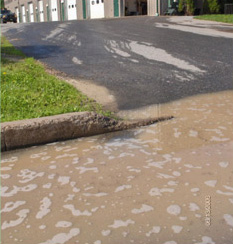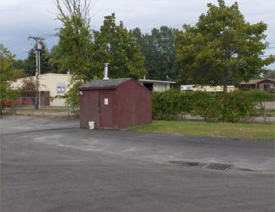Problem
Residents observed a soapy discharge in a small tributary of Potash Brook. Stormwater Utility staff investigated and traced the discharge back to a trucking facility. Fleet vehicles were being washed on a regular basis and the washwater was allowed to flow into a nearby storm drain. Vehicle washwater should not be discharged directly to surface water as it can contain high levels of sediment, oil, and phosphorus from the soap.

Description
City staff met with facility’s manager and worked to eliminate the discharge. The storm drain that collected the vehicle washwater was directed to a new oil water separator and then sent to the wastewater treatment plant for further treatment. The vehicle washing area was also re-graded to minimize the amount of water that would flow to the wastewater treatment plant during a rain storm.

Benefit
The trucking company can now wash their vehicles without discharging sediment and phosphorus to the stream.
Best Management Practices
When washing your vehicle, direct the washwater to a vegetated area so that the water can infiltrate into the ground prior to discharge. If you regularly wash numerous vehicles, you will need to collect the washwater and send it to the wastewater treatment plant. Contact the Stormwater Utility, or the Vermont Agency of Natural Resources if you have questions regarding the proper way to manage vehicle washwater.
Timeline
2006
Last Updated: 11/2009
